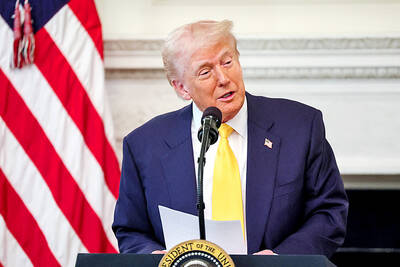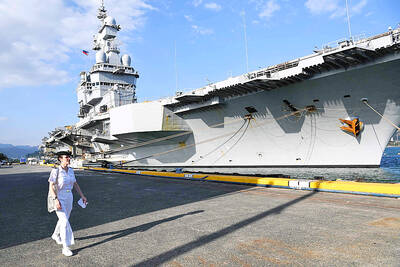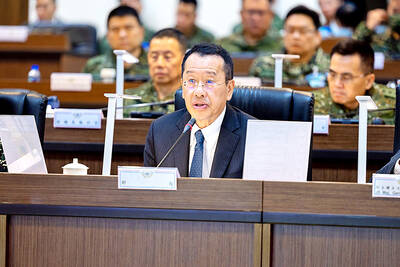Government examinations of the biggest US banks have helped lift a cloud of uncertainty that has hung over the economy.
The so-called stress tests — a key effort of the administration of US President Barack Obama to boost confidence in the financial system — showed nine of the 19 biggest banks had enough capital to withstand a deeper recession.
Ten must raise a total of US$75 billion in new capital to withstand possible future losses.
“The publication of the stress tests simply cleared the air of uncertainty,” said Allen Sinai, chief global economist at Decision Economics. “The results were not scary at all.”
He said it would take a long time for the banks to resume normal lending. But the test results didn’t alter his prediction that the economy was headed for a recovery in October or November.
The stress tests have been criticized as a confidence-building exercise whose relatively rosy outcome was inevitable. But the information, which leaked out all week, was enough to cheer investors. They pushed bank stocks higher on Wednesday and rallied again in after-hours trading late on Thursday once the results had been released.
Among the 10 banks that need to raise more capital, Bank of America Corp needs by far the most — US$33.9 billion. Wells Fargo Co needs US$13.7 billion, GMAC LLC US$11.5 billion, Citigroup Inc US$5.5 billion and Morgan Stanley US$1.8 billion.
The five other firms found to need more of a capital cushion are all regional banks — Regions Financial Corp of Birmingham, Alabama; SunTrust Banks Inc of Atlanta; KeyCorp of Cleveland; Fifth Third Bancorp of Cincinnati and PNC Financial Services Group Inc of Pittsburgh.
The banks will have until June 8 to develop a plan and have it approved by their regulators. If they can’t raise the money on their own, the government said it’s prepared to dip further into its bailout fund.
The government hopes the stress tests will restore investors’ confidence that not all banks are weak and that even those that are can be strengthened. They have said none of the banks will be allowed to fail.
Among the banks that the government did not ask to raise more capital were JPMorgan Chase & Co, brokerage house Goldman Sachs Group Inc, insurer MetLife Inc and credit card companies Capital One Financial Corp and American Express Co.
Together, the 19 firms that took the test hold two-thirds of the assets and half the loans in the US banking system.
Wells Fargo and Morgan Stanley said they will try to raise billions in fresh capital. Meanwhile, American Express became the first major financial institution to formally request permission to return federal bailout money provided under the Troubled Asset Relief Program.
Separately, Citigroup said it is planning to convert an extra US$5.5 billion of preferred shares — a kind of debt — into common stock after the stress tests determined it needs an equal amount in fresh capital.
GMAC said it will raise the US$11.5 billion mandated by the Treasury within six months, a task that could involve the federal government taking a big stake in the auto finance company.
GMAC, which reported a first-quarter loss of US$675 million, said earlier this week it has seen rising defaults in its auto finance division. That, combined with soured assets in its Residential Capital LLC mortgage unit, makes it more difficult for the company to raise the additional capital in the public markets.
The tests found that if the recession were to worsen, losses at the 19 stress-tested firms during this year and next year could total US$600 billion. Of those losses, US$185.5 billion would be from mortgages, US$82.4 billion from credit card loans and US$53 billion from commercial real estate loans — the loans on banks’ books that analysts say are now most vulnerable to default.
“Looking at the big picture, you can say that things aren’t so bad for the financial industry as a whole,” said Kevin Logan, chief US economist at Dresdner Kleinwort.
But Logan said attracting fresh capital will be a challenge for banks that need it.
“The banking industry is not going to make a lot of money going forward and that’s a dilemma for keeping banks solvent and getting them lending,” he said.
Large and regional bank stocks mostly rallied in after-hours trading as investors showed relief over the results. Bank of America rose 9.2 percent to US$14.75, while JPMorgan gained 1.5 percent to US$35.77. Fifth Third Bancorp advanced 23.4 percent to US$6.60, while Boston’s State Street Corp jumped to US$40.90, a gain of 8.1 percent.
The government’s unprecedented decision to publicly release bank exams has led some critics to question whether the findings are credible. Some said regulators seemed so intent on sustaining public confidence in the banks that the results would have to find the banks basically healthy, even if some need to raise more capital.
Jaidev Iyer, a former risk management chief at Citigroup, said regulators are playing to public expectations, which could put the government in the role of creating “winners and losers.” Because the government has said it won’t let any firm fold, taxpayers may wind up on the hook.
In the tests, the Fed put banks through a scenario that imagines how they would fare if the recession worsened. It imagined that joblessness would hit 10.3 percent next year and house prices would fall more than 22 percent.
Some analysts have questioned whether the tests were rigorous enough. For example, economists expect the jobless rate to approach or exceed 10 percent by year’s end — and to go higher next year — even if the recession doesn’t worsen.
A steeper downturn would make it harder for consumers and businesses to repay loans, which would cause banks’ assets to lose value. The government is forcing the banks to keep their capital reserves up so they can keep lending even if the economic picture darkens.
The tests measured bank reserves based on what’s known as common equity, the value of a company’s common stock and profits. Some of the banks have big enough reserves by traditional measures but fall short by this narrower standard.
“It’s not really stressful, so how could it be a stress test?” said Simon Johnson, a former chief economist with the International Monetary Fund and professor at the Massachusetts Institute of Technology. “This makes it seem like we’re not having a financial crisis at all.”
Banks that need capital have several options. Some would be able to convert the government’s debt into common stock.
“These tests will help ensure that banks have a sufficient capital cushion to continue lending in a more adverse economic scenario,” said Treasury Secretary Timothy Geithner. “They will provide the transparency necessary for individuals and markets to judge the strength of the banking system.”
Describing the purpose of the tests, Federal Reserve Chairman Ben Bernanke said at a news conference with Geithner: “This is to make sure banks have enough capital to offset the losses we know are coming in the next couple of years.”

STILL COMMITTED: The US opposes any forced change to the ‘status quo’ in the Strait, but also does not seek conflict, US Secretary of State Marco Rubio said US President Donald Trump’s administration released US$5.3 billion in previously frozen foreign aid, including US$870 million in security exemptions for programs in Taiwan, a list of exemptions reviewed by Reuters showed. Trump ordered a 90-day pause on foreign aid shortly after taking office on Jan. 20, halting funding for everything from programs that fight starvation and deadly diseases to providing shelters for millions of displaced people across the globe. US Secretary of State Marco Rubio, who has said that all foreign assistance must align with Trump’s “America First” priorities, issued waivers late last month on military aid to Israel and Egypt, the

France’s nuclear-powered aircraft carrier and accompanying warships were in the Philippines yesterday after holding combat drills with Philippine forces in the disputed South China Sea in a show of firepower that would likely antagonize China. The Charles de Gaulle on Friday docked at Subic Bay, a former US naval base northwest of Manila, for a break after more than two months of deployment in the Indo-Pacific region. The French carrier engaged with security allies for contingency readiness and to promote regional security, including with Philippine forces, navy ships and fighter jets. They held anti-submarine warfare drills and aerial combat training on Friday in

COMBAT READINESS: The military is reviewing weaponry, personnel resources, and mobilization and recovery forces to adjust defense strategies, the defense minister said The military has released a photograph of Minister of National Defense Wellington Koo (顧立雄) appearing to sit beside a US general during the annual Han Kuang military exercises on Friday last week in a historic first. In the photo, Koo, who was presiding over the drills with high-level officers, appears to be sitting next to US Marine Corps Major General Jay Bargeron, the director of strategic planning and policy of the US Indo-Pacific Command, although only Bargeron’s name tag is visible in the seat as “J5 Maj General.” It is the first time the military has released a photo of an active

CHANGE OF MIND: The Chinese crew at first showed a willingness to cooperate, but later regretted that when the ship arrived at the port and refused to enter Togolese Republic-registered Chinese freighter Hong Tai (宏泰號) and its crew have been detained on suspicion of deliberately damaging a submarine cable connecting Taiwan proper and Penghu County, the Coast Guard Administration said in a statement yesterday. The case would be subject to a “national security-level investigation” by the Tainan District Prosecutors’ Office, it added. The administration said that it had been monitoring the ship since 7:10pm on Saturday when it appeared to be loitering in waters about 6 nautical miles (11km) northwest of Tainan’s Chiang Chun Fishing Port, adding that the ship’s location was about 0.5 nautical miles north of the No.